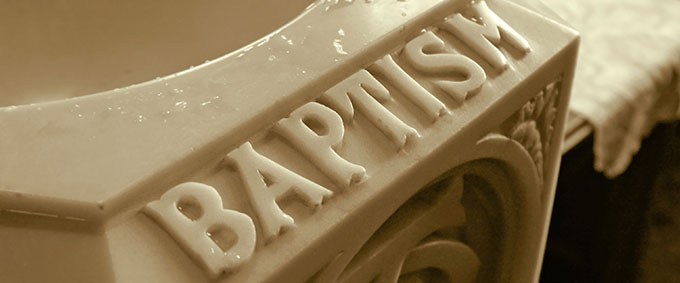What Happens at Baptism?
An Overview of the Sacrament

Jim and Maria stand at the baptismal font holding their baby daughter, Elizabeth, between them. They are surrounded by family, friends, and Elizabeth’s godparents. The deacon asks, “What do you ask of the Church for this child?” It’s a meaningful question.
“Baptism,” the couple replies, giving an even more meaningful answer.
Baptism is not a small thing. Using such potent symbols as water, oil, and fire, Baptism is a powerful sacrament that washes away original sin and its effects. It gives us a new identity, connects us to a new community of believers, initiates us into a new way of living, and provides a clear mission in life. Baptism has meaning on many levels.
Historical
Within weeks of Jesus’ Resurrection, the apostles were preaching the Gospel to people by the thousands, baptizing them in Jesus’ name. Since then, Baptism has been the ordinary means of becoming a member of the Church. Think of the long line of people before you—parents, grandparents, and spiritual ancestors—who were welcomed into the Church at Baptism.
Theological
Baptism is a sacrament of initiation, cleansing, strengthening, and welcoming. Baptism welcomes us into the community of Christian believers. It offers us a new life in which we become the adopted children of God, followers of Christ, and temples in which the Holy Spirit dwells. Baptism leaves a permanent spiritual mark on our soul that makes us holy and opens us to salvation and eternal life with God.
Physical
Like any sacrament, Baptism makes visible an invisible reality. In other words, we use physical signs and rituals to express our experience of God and his grace in our lives. The symbols you see at a Baptism ceremony include the following:
The Sign of the Cross is traced on the forehead of the one being baptized. This ritual action expresses that the mystery of the cross is at the heart of our faith.
The immersion in water (or pouring on of water) of the one being baptized reminds us that we die with Jesus to conquer sin and rise with him so we might enter into new life. In this action we are reminded of how Moses led the Hebrews on their escape from Egypt and how he parted the waters of the Red Sea as the gateway to liberation, away from slavery and into the Promised Land. We also recall Jesus’ death and Resurrection, which free us from sin and bring us into a new way of living. Many new or remodeled churches have the baptismal font near the main entrance to symbolize that we all enter the church through the waters of Baptism.
The words of Baptism, “I baptize you in the name of the Father, and of the Son, and of the Holy Spirit,” are spoken while the water is poured or the one to be baptized is immersed. These words reveal that God in the Trinity is both the source of life and our life’s goal.
The newly baptized is anointed with sacred oil to signify that the Holy Spirit dwells within the heart of this new Christian. It’s also a sign of being anointed to a mission to live and love as Jesus lived.
A white garment reflects that in Baptism we “put on Christ,” taking our new and truest identity as a son or daughter of God.
A baptismal candle, lit from the Easter candle, represents the one true light of Christ, a light to guide the new believer throughout his or her life.
Cultural
Families often celebrate and affirm all that happened at the altar by gathering after the ceremony to tell stories, enjoy one another’s company, share a meal, and in their own ways, celebrate who they are and what they believe. Everyone present gets a chance to hold the new baby and offer his or her blessings and best wishes for a life of happiness, holiness, and faith.
What happens at a Baptism? The Church rejoices because we have welcomed a new member and because we have once again celebrated the mysteries of God's love for us and of our salvation.

